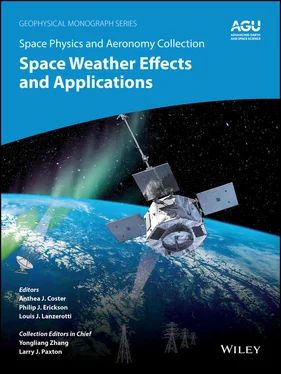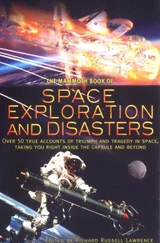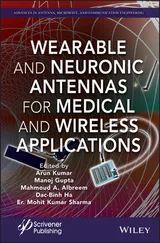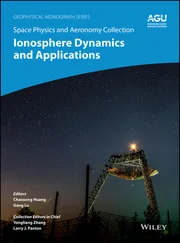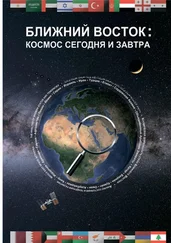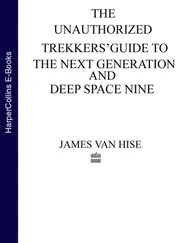Figure 2.37 Incident fluence to first discharge during low flux exposures... Figure 2.38 Number of discharges per orbit (lower panel) is driven by the in... Figure 2.39 Pulses/orbit by sample types with geometries listed in table.... Figure 2.40 Scatter plot of pulse count/orbit vs electron fluence for each o... Figure 2.41 The IDM insulator pulses (second panel) and CRRES anomalies (thi... Figure 2.42 CRRES IDM pulse rate (bars, top panel), spacecraft anomaly rate ...Figure 2.43 Review of space weather prior to Anik failures implicated deep c...Figure 2.44 Energetic electron flux history from the launch of Anik E1 and E...Figure 2.45 Correlation of AME switching anomalies on DRA‐δ with peaks in 48...Figure 2.46 Telstar 401 failure was preceded by significant energetic electr...Figure 2.47 Episode of elevated energetic electron flux preceding the G4 and...Figure 2.48 G4 and other similar spacecraft had been exposed to much higher ...Figure 2.49 Relationship of anomalies to energetic electron flux (7‐day aver...Figure 2.50 Example of 54 anomalies on one spacecraft correlated with the ex...Figure 2.51 Internal energetic electron flux responsible for the anomalies w...Figure 2.52 Parametric study of the buildup and decay of trapped charge insi...Figure 2.53 Common elements of command control circuits.Figure 2.54 Radiation‐induced conductivity from high‐energy penetrating elec...Figure 2.55 Effect of temperature on resistivity for a range of activation e...
3 Chapter 3Figure 3.1 Relative abundances of galactic cosmic ray element species at 1 G...Figure 3.2 Energy spectra for representative GCR elements displaying typical...Figure 3.3 Energetic proton spectra for the 30 September 1998 impulsive sola...Figure 3.4 Energetic proton spectra for the 24 September 2001 gradual solar ...Figure 3.5 Proton energy spectra for the 19 October 1989 series of SEP event...Figure 3.6 Monthly sunspot numbers and smoothed monthly sunspot numbers vers...Figure 3.7 Proton energy spectra for the SEP events of 24–27 August 1998 (le...Figure 3.8 Proton integral fluence spectra for the August 1972 and 19–24 Oct...Figure 3.9 August 1972, February 1956, and AD775 SEP event proton spectra.
4 Chapter 4Figure 4.1 The complex radiation conditions at and above commercial aviation...Figure 4.2 GCR spectral flux for various nuclei predicted by the Badhwar and...Figure 4.3 Wilcox Solar Observatory solar polar magnetic field measurements....Figure 4.4 ARMAS effective dose rates substantially increase between 4 ≤ L ≤...Figure 4.5 The ARMAS 3 October 2015 G5 flight at 11.5 km and magnetic latitu...Figure 4.6 One‐minute ratios of ARMAS (measurements) to NAIRAS (model; GCR a...Figure 4.7 Zonal‐averaged vertical geomagnetic cutoff rigidity. The solid re...Figure 4.8 Global grid of quiescent vertical geomagnetic cutoff rigidities (...Figure 4.9 Simulated vertical geomagnetic cutoff rigidity shown over the nor...Figure 4.10 Characteristic scattering length for ion beam transport through ...Figure 4.11 Average range versus kinetic energy of an ion beam incident at t...Figure 4.12 Stopping power versus kinetic energy of incident ions on Earth’s...Figure 4.13 Event‐averaged GCR spectral fluence rates at zero vertical geoma...Figure 4.14 Event‐averaged SEP spectral fluence rates at zero vertical geoma...Figure 4.15 Nuclear survival probability versus kinetic energy of an ion bea...Figure 4.16 The green lines show the fluence‐to‐effective dose conversion co...Figure 4.17 Normalized spectral effective dose rates evaluated during the Ha...
5 Chapter 5Figure 5.1 Major pathways by which space weather couples to satellite aerody...Figure 5.2 (a) Global average number density profiles at solar maximum (F 10....Figure 5.3 LEO object population densities and future potential constellatio...Figure 5.4 (a) Flow regimes according to the Knudsen number for gas dynamics...Figure 5.5 The altitude‐variable drag coefficient for a SL6 cylindrical rock...Figure 5.6 Various methods of estimating energy accommodation compared with ...Figure 5.7 Partial pressures for thermosphere species as determined by MSIS....Figure 5.8 Altitudinal and latitudinal variations in mass density change dur...Figure 5.9 GRACE‐A panel model C DxA as a function of He/O ratio at two value...Figure 5.10 F 10.7daily and 81‐day smoothed values from 1 January 1997 to 1 ...Figure 5.11 S 10.7daily and 81‐day smoothed values from 1 January 1997 to 1 ...Figure 5.12 M 10.7daily and 81‐day smoothed values from 1 January 1997 to 1 ...Figure 5.13 Y 10.7daily and 81‐day smoothed values from 1 January 1997 to 1 ...Figure 5.14 F 10.7,S 10.7,M 10.7,and Y 10.7daily and 81‐day smoothed values ...
6 Chapter 6Figure 6.1 Examples of solar type IV spectral fine structures observed at L ...Figure 6.2 Cumulative number of bursts per day at frequencies above 2 GHz (a...Figure 6.3 The percentages (on an hourly basis) of dropped calls averaged ov...Figure 6.4 Radio light curves in sfu of the 4 November 2015 event from the H...
7 Chapter 7Figure 7.1 TEC from the International Reference Ionosphere that illustrates ...Figure 7.2 Example image showing the ionospheric plasma frequency (color) wi...Figure 7.3 Three ionospheric propagation paths, for the same frequency and l...
8 Chapter 8Figure 8.1 The top and middle panels show the comparison between model estim...Figure 8.2 The 30‐minute average 2D map of a GNSS TEC snapshot that shows st...Figure 8.3 GPS scintillation observations (black circles) overlaid onto a GP...Figure 8.4 Plots available through the Cedar Madrigal web site illustrating ...Figure 8.5 The panels on the left side show the vertical electron density di...Figure 8.6 The statistical view of GNSS ROTI distribution as a function of l...
9 Chapter 9Figure 9.1 Sunspot cycles and the occurrence and intensity (using Ap index) ...Figure 9.2 Growth of the US high‐voltage transmission network and the annual...Figure 9.3 Vector intensity of geomagnetic field disturbances at numerous ma...Figure 9.4 Magnetic field environment model using the vector data from Figur...Figure 9.5 Peak geo‐electric field from a 2400 nT/min electrojet threat.Figure 9.6 Multiple 1‐D ground models for the US grid.Figure 9.7 Comparison of calculated and measured electric fields for 4 Nov 1...Figure 9.8 Comparison of measured and calculated GIC waveforms at Chester, M...Figure 9.9 Map of 345 kV, 500 kV, and 765 kV substations and transmission ne...Figure 9.10 Miles of 345 kV, 500 kV, and 765 kV transmission lines in US gri...Figure 9.11 Number of 345 kV, 500 kV, and 765 kV transformers in US grid mod...Figure 9.12 Range of transmission line resistance for the major kV‐rating cl...Figure 9.13 Transformer MVAr increase versus GIC for 500 kV single phase and...Figure 9.14 Transformer MVAr increase versus GIC for 345 kV, 500 kV, and 765...Figure 9.15 Demographic estimates of 345 kV transformers: single phase vs. t...Figure 9.16 Demographic estimates of 500 kV transformers: single phase vs. t...Figure 9.17 Demographic estimates of 765 kV transformers: single phase vs. t...Figure 9.18 BPA 500 kV transformer demographics: single phase vs. three phas...Figure 9.19 BPA 230 kV transformer demographics: single phase vs. three phas...Figure 9.20 Normal excitation current in 500 kV transformer.Figure 9.21 Distorted excitation current with 5 Amps/phase of GIC.Figure 9.22 Distorted excitation current with 25 Amps/phase of GIC.Figure 9.23 Distorted excitation current with 100 Amps/phase of GIC.Figure 9.24 Transformer total load current: normal conditions (blue) and wit...Figure 9.25 Pattern of geoelectric field and GIC flows in New England region...Figure 9.26 Peak dB/dt observed by region on 13–14 March 1989.Figure 9.27 GIC and geoelectric field conditions: 7:45 UT, 13 March 1989.Figure 9.28 Simulation of geomagnetic conditions at 11:26 UT on 13 March 198...Figure 9.29 Reported North American power system impacts, 13 March 1989 for ...Figure 9.30 Reported North American power system impacts, 13 March 1989 for ...Figure 9.31 Simulated 21:50 UT, 13 March 1989, conditions.Figure 9.32 Simulated 22:00 UT, 13 March 1989, conditions. The intense geoma...Figure 9.33 Simulation of US power grid conditions at 21:44 UT on 13 March 1...Figure 9.34 Simulation of US power grid conditions at 21:51 UT on 13 March 1...Figure 9.35 Simulation of US power grid conditions at 21:57 UT on 13 March 1...Figure 9.36 Simulation of US power grid conditions at 22:09 UT on 13 March 1...Figure 9.37 Reported North American power system impacts, 13–14 March 1989 f...Figure 9.38 Simulated 01:20 UT, 14 March 1989, conditions.Figure 9.39 World map of measurement sites considered for the evaluation of ...Figure 9.40 Comparison of the measured SI event on 18 March 2002 at 13:23 UT...Figure 9.41 Locations of the four magnetometer sites for electrojet comparis...Figure 9.42 Horizontal B fields at four sites for 29 October 2003.Figure 9.43 Tromso horizontal B‐fields for 4‐month period in 1994.
Читать дальше
